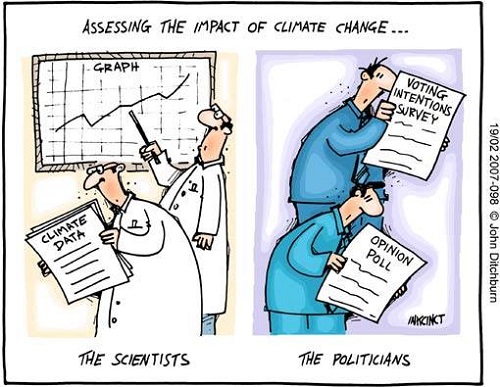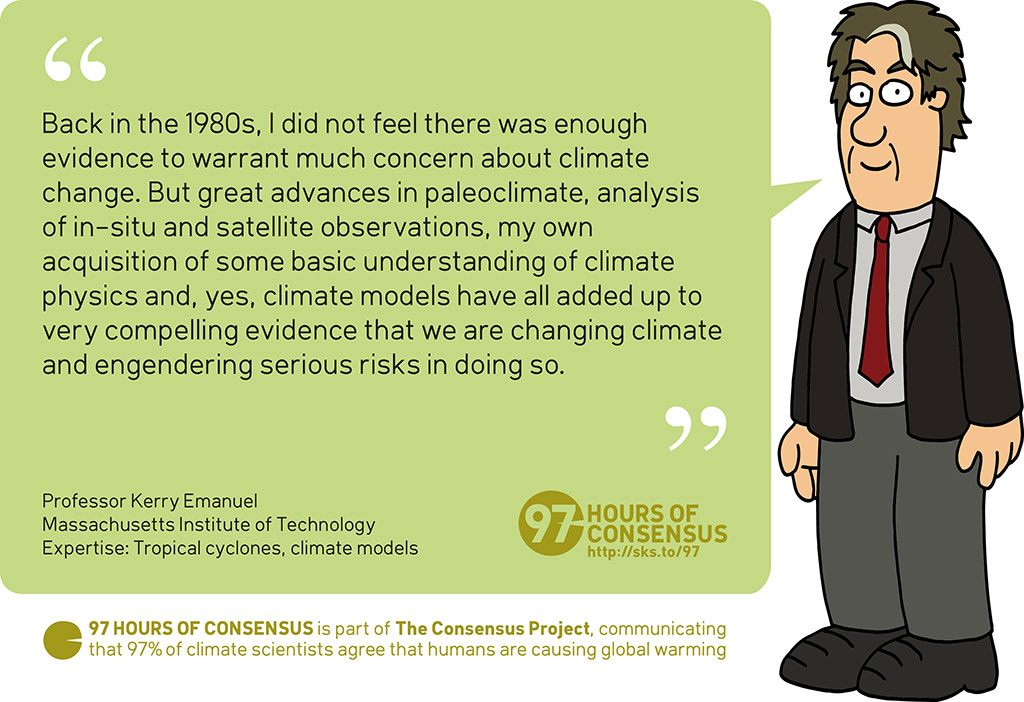2015 SkS Weekly Digest #15
Posted on 12 April 2015 by John Hartz
SkS Highlights
The history of emissions and the Great Acceleration by Andy Skuce generated the highest number of comments of the articles posted on SkS during the past week. Coming in second and third, repectively, were Global warming hiatus explained and it's not good news by Graham Readfearn, and The global warming 'pause' is more politics than science by Dana.
El Niño Watch
The National Oceanic and Atmospheric Administration (NOAA) is predicting a 60 percent chance that the El Niño it declared in March will continue all year. An El Niño is a weather pattern “characterized by unusually warm ocean temperatures in the Equatorial Pacific.”
There’s A 60 Percent Chance El Niño Could Last All Year by Joe Romm, Climate Progress, Apr 10, 2015
Toon of the Week

Hat tip to I Heart Climate Scientists
Quote of the Week
In case you weren't already worried about the current and rapid acidification of the world's oceans, a new report by leading scientists finds that this very phenomenon is to blame for the worst mass extinction event the planet earth has ever seen—approximately 252 million years ago.
The findings, published this week in the journal Science by University of Edinburgh researchers, raise serious concerns about the implications of present-day acidification, driven by human-made climate change.
"Scientists have long suspected that an ocean acidification event occurred during the greatest mass extinction of all time, but direct evidence has been lacking until now," said lead author Dr. Matthew Clarkson in a statement. "This is a worrying finding, considering that we can already see an increase in ocean acidity today that is the result of human carbon emissions."
Oceans Facing Carbon Rates Which Spurred Mass Die-Off 250 Million Years Ago by Sarah Lazare, Common Dreams, Apr 10, 2015
SkS in the News
In her Al Jazeera America article, Climate change: no room for debate?, Stephanie Becker includes the following:
97% of Published Reports Agree Climate Change is Fueled by Man-Made Greenhouse Gas Emissions:
Everyone from President Obama to climate scientists themselves misrepresent this figure, often noting that 97% of scientists say that climate change exists and it is humankind’s fault. The 97% figure actually refers to published papers linking climate change to manmade greenhouse gas emissions. 97% of that research points to fossil fuel emissions of C02 for climate change. It’s a big number. Nevertheless, there’s a tiny minority of scientists who disagree with the vast majority of scientists who say greenhouse gas emissions are causing the earth’s climate to change at an unnatural pace.
Coming Soon on SkS
- Andy Lacis responds to Steve Koonin (ATTP)
- Hungarian Translation of the Debunking Handbook (András G. Pintér) 
- 2015 SkS Weekly News Roundup #16A (John Hartz)
- 65 Canadian scholars draw a roadmap to curb global warming (Dana)
- Western Canada’s glaciers could shrink by as much as 95% by 2100, study finds (Robert McSweeney)
- Guest Post (John Abraham
- 2015 SkS Weekly News Roundup #16B (John Hartz)
- 2015 SkS Weekly Digest #16 (John Hartz)
Poster of the Week

SkS Week in Review
- 2015 SkS Weekly News Roundup #15B by John Hartz
- New paper shows how sensitive the ocean biosystem is to climate change by John Abraham
- Global warming hiatus explained and it's not good news by Graham Readfearn
- 2015 SkS Weekly News Roundup #15A by John Hartz
- The global warming 'pause' is more politics than science by Dana
- The history of emissions and the Great Acceleration by Andy Skuce
- A revealing interview with top contrarian climate scientists by Dana
- 2015 SkS Weekly Digest #14 by John Hartz
97 Hours of Consensus: Kerry Emanual
































 Arguments
Arguments






























I'm not quite sure where to put this, it may not be within the remit of this site. I'm just wondering if this might be an example of 'misinformation' from team environment.
"According to the Rodale Institute, small-scale farmers and pastoralists could sequester more than 100% of current annual CO2 emissions with a switch to widely available, safe and inexpensive agroecological management practices that emphasize diversity, traditional knowledge, agroforestry, landscape complexity, and water and soil management techniques, including cover cropping, composting and water harvesting."
http://www.commondreams.org/views/2015/04/13/food-farming-and-climate-change-its-bigger-everything-else
WIthout a background in ag science, I can't evaluate the truthiness of that.
Tristan @1, similar claims have been made on SkS before, and discussed in detail. The validity of the claim depends, however, on the way it is formulated. In this case, based on IPCC AR5 figures, to counterbalance total annual anthropogenic emissions, humans need only increase total terrestial photosynthesis (ie, Gross Primary Productivity) by 8.9 GtC, or 7.24%. That is, of course, the figures for all terrestial photosynthesis, not just crop land. Taking the figures of Haberl et al (2007), that equates to increasing agricultural productivity by 57.1% of current human appropriation of net primary productivity or 107.6% of the current harvestable yield.
I don't know whether that is technically feasible, but it does not present a theoretical bar. However, that increase must be the increase in persistent biomass. Any actual crop, whether consumed by humans or as fodder for animals, returns to the atmosphere as CO2, and hence is not sequestered. The sequestration, therefore, is limited to the annual increase in standing biomass and soil biomass. Here, however, you face a problem. Based on the IPCC AR5, human activity has reduced terrestial biomass by just 30 GtC since the industrial revolution. That is, if we could manage that rate of sequestration, we would have to exceed natural levels of sequestration within 3.4 years. That figure is less the increase in biomass due to increased temperature, water, CO2 and the agricultural revolution. On an alternative measure, we would be exceeding natural levels 18.4 years (remember to convert from GtCO2 to GtC if checking the figures). Allowing for preindustrial levels, we might have 36 to 40 years of such sequestration before we reached a situation where the land simply would not hold more biomass. So, while such high rates of sequestration cannot be excluded, neither can they be maintained sufficiently to provide a long term solution.
Finally, many of the changes suggested require convesion to small scale, labour intensive farming (permaculture). The problem with that is it requires the majority of the population to be farmers. It represents a retreat back to a dark age, where we do not have sufficient resources to maintain a system of universities and scholarship, or of mass entertainment (which may be of interest to more people).
I am not suggesting that implication of the methods advocated by Savory or the Rodale institute are not worthwhile in themselves, or that they will not help. They are just not a silver bullet for global warming, and they make themselve incredible (ie, not capable of being believed) by suggesting otherwise.
Thank you very much Tom, I appreciate you spelling it out to me.
March GIS L-OTI is out: 0.84C. That's the 5th warmest month and the 3rd warmest March. The 12-month period ending in March is the warmest in the record, beating the periods ending in February (now 2) and January (now 3). Feb-Mar Multivariate ENSO Index was .65.
DSL,
What was the period ending in December? How far back do you need to go to get out of the current record streak?
Correction - forgot to update the rest of the dataset (can someone delete my last two posts?):
Still the 5th warmest month. Still the 3rd warmest March.
The 12-month period rankings for the last six months: 7, 18, 6, 4, 2, 1 (March).
The 36-month period rankings for the last six months: 14, 22, 15, 3, 2, 1 (March).
[PS] Deleted previous post as requested. The one previous is needed to make sense of it.
I'm hoping it is okay to post something slightly off-topic...
I googled for 'real climate' because the PC I was on did not have the Real Climate page bookmarked, and was somewhat surprised to see this as the third link in the Google results:
http://thefederalist.com/2015/04/17/what-it-would-take-to-prove-global-warming/
The material at the end of the link is obviously thoughtless denialist nonsense, but the question is: why it is so highly ranked in Google? Is thefederalist.com doing some dodgy search engine optimisation (SEO), or is Google giving this site more profile than it deserves?
If there are are dodgy SEO tactics being employed, I will complain directly to Google, who usually respond to such complaints by re-ranking the dodgy site.
If it is Google who is pedalling this nonsense, a different response is appropriate.
Hoping some of you have some insights.
Cheers,
Leto.